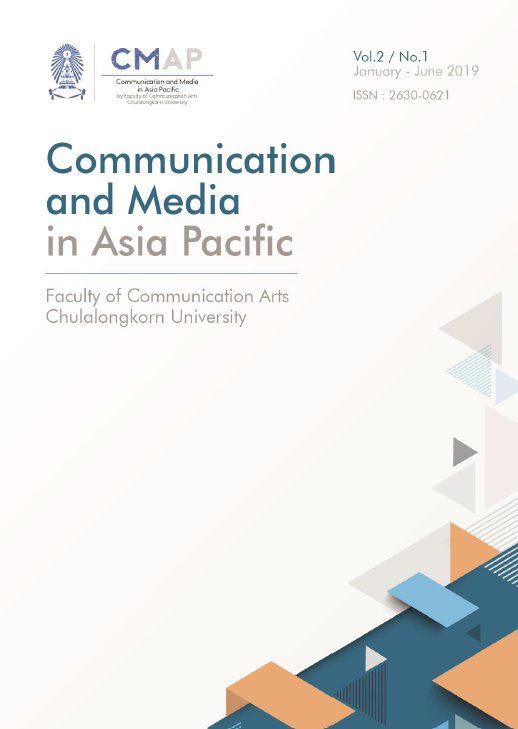Interactive Communication Design to Enhance Tourists’ Traveling Experiences in Chiang Rai
Main Article Content
Abstract
This study was qualitative-action research, which focused on developing interactive communication tools based upon modern technologies; such as, smartphone and augmented reality (AR) technology for developing an interesting tourism map in order to provide destination information to Thai and foreign tourists who were interested in visiting Chiang Rai and the nearby areas. This was conducted to enhance tourists’ travel experiences.
The researcher used a combination of qualitative research and action research in gathering information from stakeholders; such as, tourism policymakers, professionals, representatives of tourism associations and related businesses, as well as, academics and tourists in the local areas. The information was utilized in designing an interactive communication tool to enhance the tourists’ experience in order to promote the tourism industry in Chiang Rai.
Four prototypes of the communication tools were developed and were classified in to four frameworks, which were; A Chiang Rai tourist destination map in general; A Chiang Rai map focused on each tourist attraction; A One-day travel map (based on a concept of the slow life journey) and postcards to promote Chiang Rai tourism. The result of tools testing was considered as satisfactory by tourism policymakers, professionals, representatives of tourism associations, related businesses, as well as, tourists in the local areas and these tools should be further developed to use in promoting tourism in Chiang Rai and other provinces in Thailand.
Article Details
References
AppAdvice. (2016, December 4). Bedo Dusit Zoo. Retrieved September 2, 2018, from https://appadvice.com/app/bedo-dusit-zoo/1166072421
Azuma, R. T. (1997). A survey of augmented reality. Presence: Teleoperators & virtual environments. 6(4), 355-384.
Behance. Showcase & discover creative work. Retrieved July 6, 2018, from https://www.behance.net
Borrero, A. M., & Marquez, J. M. A. (2012). A pilot study of the effectiveness of augmented reality to enhance the use of remote labs in electrical engineering education. Journal of Science Education and Technology. 21(5), 540-557.
Kositpipat, C. (2012). Watrongkhun Chiang Rai. Retrieved September 2, 2013, from http://www.watrongkhun.org/
Kumsaen, C., & Roengsiri, S. (2007). Tourists’ travelling behavior in Chiang Rai. Master’s thesis, Chiang Rai Rajabhat University, Chiang Rai.
Chavouet, F. (2011). Tokyo on Foot: Travels in the city’s most colorful neighborhoods. Tokyo: Tuttle Pub.
Chiangrai Statistiscal Office. (2013). Development plan for Chiangrai year 2010-2013. Retrieved September 2, 2013, from http://chiangrai.nso.go.th/chrai54/plancr2553_2556.pdf
Chiangraifocus. (2007). Online society for Chiangrai. Retrieved September 2, 2013, from http://www.chiangraifocus.com/
Dasey, D. (2017). Try before you buy. Retrieved September 2, 2018, from https://highlights.ikea.com/2017/ikea-place/
Department of Tourism. (2011). Summary of tourist situation. 2005-2010. Retrieved September 2, 2013, from http://www.tourism.go.th
Folktravel. (2013). Data travel of Chiangrai. Retrieved September 2, 2013, from http://www.folktravel.com/archive/chiangrai.html
Gaudiosi. J. (2016, August 28). Doctors using VR to aid in neurosurgery is a no-brainer. Retrieved September 2, 2018, from http://uploadvr.com/surgical-theater-neurosurgeons/
Sathapornwachana, J., & Muangsun, S. (2013). The design and development of textbook with augmented reality technology of 3 dimensions on illustration. Bangkok: Rajamangala Univeristy of Technology Rattanakosin.
Klinnhoo, J. (2013). The application of artificial intelligence technology in creating electronic lesson and learning activities concerning security of information technology to enhance academic achievement of information and technology course. Retrieved September 6, 2018, from http://oer.thaicyberu.go.th/handle/6626105234/847
Boonmaruen, K. (2003). Factors Affecting International Tourist Travels. Unpublished Master’sthesis, Chiang Mai University, Chiang Mai.
Kipper, G., & Rampolla, J. (2012). Augmented reality: An emerging technologies guideto AR. Boston: Syngress.
Siripullop, K. (2004). Value creation of online brand. Retrieve September 2, 2013, from http://www/bus.tu.ac.Th/usr/kitti/brand.doc
Kotler, P. & Armslrong, G. (2006). Principles of Marketing (11st ed.). New Jersey: Prentice Hall.
Kumar, S. (2016). 7 Amazing facts about augmented reality: Your tech world. Retrieved September 6, 2018, from http://www.augrealitypedia.com/7-amazing-facts- augmented-reality-tech/
Luxuo. (2011, April 7). Tissot augmented reality window at harrods. Retrieved September 2, 2018, from http://www.luxuo.com/style/watches/tissot-augmented-reality-window-display-harrods.html
Lamb, C. W., & Joseph, F. (2001). Hair and Carl Mc Daniel. Essentials of Marketing. Australis:South-Western College Pub.
Layar. (2012). Easily create your own interactive augmented reality experiences. Retrieved September 4, 2018, from http://layar.com
Balderston, M. (2017, December 7). We Are TV Uses AR To Evolve TV Experience. Retrieved September 2, 2018, from https://www.tvtechnology.com/news/we-are-tv-uses-ar-to-evolve-tv-experience
Gardner, N. (2009). Slow travel Europe making conscious choices. Retrieved September 2, 2018, from http://www.slowtraveleurope.eu/slow-travel-manifesto
One Fed Day. (2009). A whimsical personal touch-cute maps. Retrieved October 12, 2013, from https://www.onefabday.com/cute-maps-wedding-stationery/
Tansiri, P. (2010). Augmented reality. Executive Journal, 30(2), 169-175.
Duangsanit, P. (2002). Foreign tourists’ opinions towards the services of tourist guides in Chiang Rai province. Unpublished Master’s thesis, Chiang Mai University, Chiang Mai.
Pinterest. (2009). Belle amour less of the traditional & more of the original. Retrieved September 3, 2018, from https://www.pinterest.com/pin/533465518337594809/
Postcard TW-437349. (2009). Postcrossing. Retrieved September 2, 2018, from http://postcrossing.com/postcards/TW-43734
Choompolsathean, P. (2001). Strategic Marketing Communication. Bangkok: SE-ED Education. PCl.
Dachum, P. (2009). Creative tourism development: From concepts to practice for Thailand. Silpakorn University Journal, 33(2), 329-364.
Maad, S., Grabaya, S., & Bouakaz, S. (2008). From virtual to augmented reality in financial trading: A CYBERII application. Journal of Enterprise Information Management, 21(1), 71-80.
Kumar, S. (2016). How does an augmented reality application work? Retrieved September 2, 2018, from http://www.quora.com/How-does-an-augmented-reality-application-work
UNWTO. (2013).Why Tourism?. Retrieved October 5, 2013, from http://www2.unwto.org/content/why-tourism Smithlitha, V. (2016). What is Augmented Reality (AR). Retrieved September 2, 2018, from
https://broadcast.nbtc.go.th/bcj/2559/doc/2559_10_4.pdf
Lohachala, W. (2002). Oversea Tourist Satisfaction with the Selection of Accomodations in
Chiang Rai Province. Unpublished Master’s Thesis, Chiang Mai University, Chiang Mai.
Yuen, S., Yaoyuneyong, G., & Johnson, E. (2011). Augmented reality: An overview and five directions for AR in education. Journal of Educational Technology Development and Exchange. 4(1), 119-140.

